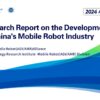Since the beginning of the year, discussions around the “Six Little Dragons of Hangzhou” have shown no signs of cooling down. The question remains: who will emerge as a key player in the AI and robotics race ahead? Not to be outdone, Shenzhen has stepped up with its own “Eight King Kongs of Robotics,” followed by the rollout of a dedicated humanoid robotics policy—signaling its determination to go head-to-head with Hangzhou.
Yet, this is only the tip of the iceberg when it comes to Shenzhen’s humanoid robotics industry. From technological breakthroughs to scenario-based deployments, the city’s ambition and capabilities go far beyond what meets the eye—and shouldn’t be underestimated.
Three Evolving Categories of Players
According to the New Strategic Institute of Mobile Robotics Industry, China is now home to over 100 companies focused on humanoid robot development. Of these, over 60% are concentrated in just three cities: Beijing, Shanghai, and Shenzhen.
Shenzhen alone boasts more than 18 companies engaged in the R&D and manufacturing of humanoid robot bodies, with most clustered in the Yuehai subdistrict of Nanshan District. The city features a diverse mix of players, ranging from long-standing tech pioneers to innovative startups and cross-industry entrants.

Chart: Shenzhen part of the humanoid robot body R & D enterprises / organizations






Tencent exemplifies how internet tech giants are making inroads into humanoid robotics. In 2018, it launched the Robotics X Lab, and in 2024, it unveiled “XiaoWu,” a humanoid robot that combines the strengths of both wheeled and legged systems, offering high mobility and obstacle-crossing capabilities. Leveraging its strengths in AI, cloud computing, and big data, Tencent is advancing the integration of humanoid robots into smart lifestyles—demonstrating the disruptive potential of internet companies in this field.
Xpeng Motors, meanwhile, marks the entry of automotive companies into the humanoid robotics arena. Through strategic investment, it has steadily expanded its robotics footprint. In 2020, Xpeng acquired Doge Robotics and founded Xpeng Robotics. In 2024, it launched the Iron AI robot, featuring proprietary chips and full-stack support for large models. The Iron robot is designed for deployment in manufacturing and retail environments.

Closing Remarks: A Carefully Orchestrated Storm
On February 23, Shenzhen unveiled its full inventory of artificial intelligence and robotics enterprises: the city is now home to over 2,600 AI companies, including six unicorns, as well as 34 publicly listed robotics companies and nine robotics unicorns. Behind these figures lies a deliberate, long-term strategy encompassing industrial chain development, talent acquisition, and capital investment.
Yet Shenzhen’s ambitions go far beyond a strong industrial foundation. The next phase will see intensified efforts across four key dimensions: policy support, application scenarios, innovation, and robotics advancement. A 10-billion-yuan industry fund dedicated to artificial intelligence and robotics will soon be established, focusing on software, hardware, and embodied intelligence. The fund aims to back high-growth enterprises and ease their access to financing.
In addition, Shenzhen plans to roll out a specialized policy initiative for humanoid robotics. Through mechanisms such as competitive bidding for key challenges, the city will offer targeted support for open application scenarios, breakthroughs in core technologies, the construction of dedicated datasets, and the scaling up of manufacturing and deployment capacity. Moreover, AI and robotics will be formally included as part of the city’s major science and technology initiatives, encouraging cross-sector innovation consortia composed of industry, academia, research, and end-users to collaborate on technological bottlenecks.
However, technological maturity and large-scale industrialization cannot be achieved overnight. As Shenzhen pushes the frontiers of R&D, it must also confront the pressing challenges of overcoming manufacturing bottlenecks and effectively translating innovation into commercial-scale applications.
With continuous advancements in technology, the demand for AI and robotics applications will only become more diverse. Whether Shenzhen can lead the next global wave of industrial transformation will depend not only on technological breakthroughs but also on its ability to commercialize innovations, integrate its ecosystem, and scale sustainably.
This brewing “storm” may well be just the beginning—because the true test is only just getting underway.




探索者论坛-scaled.jpg)
